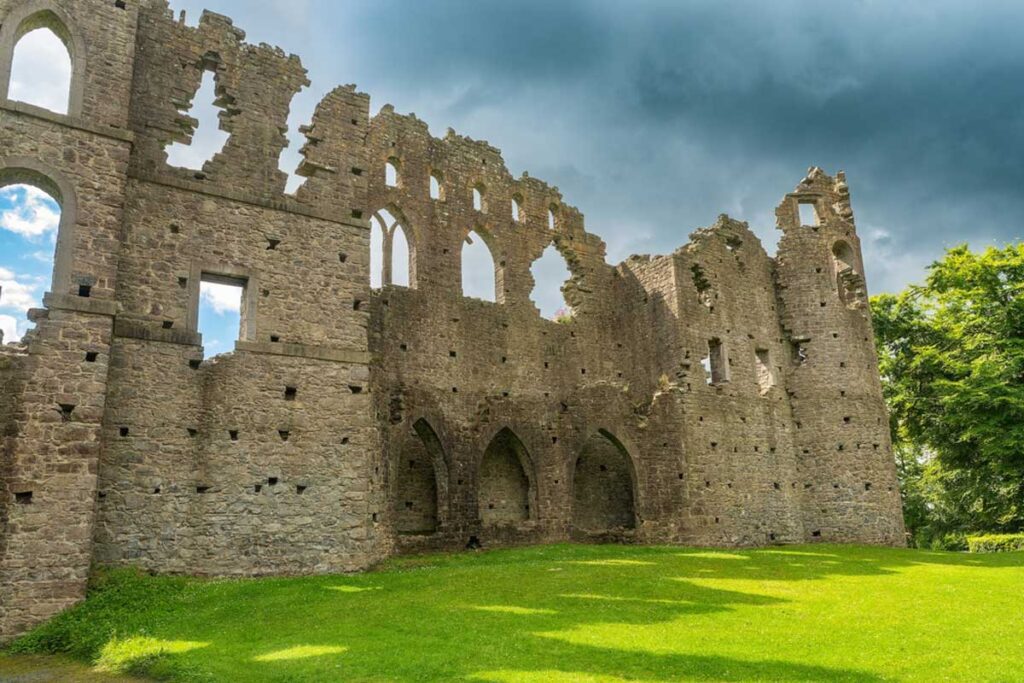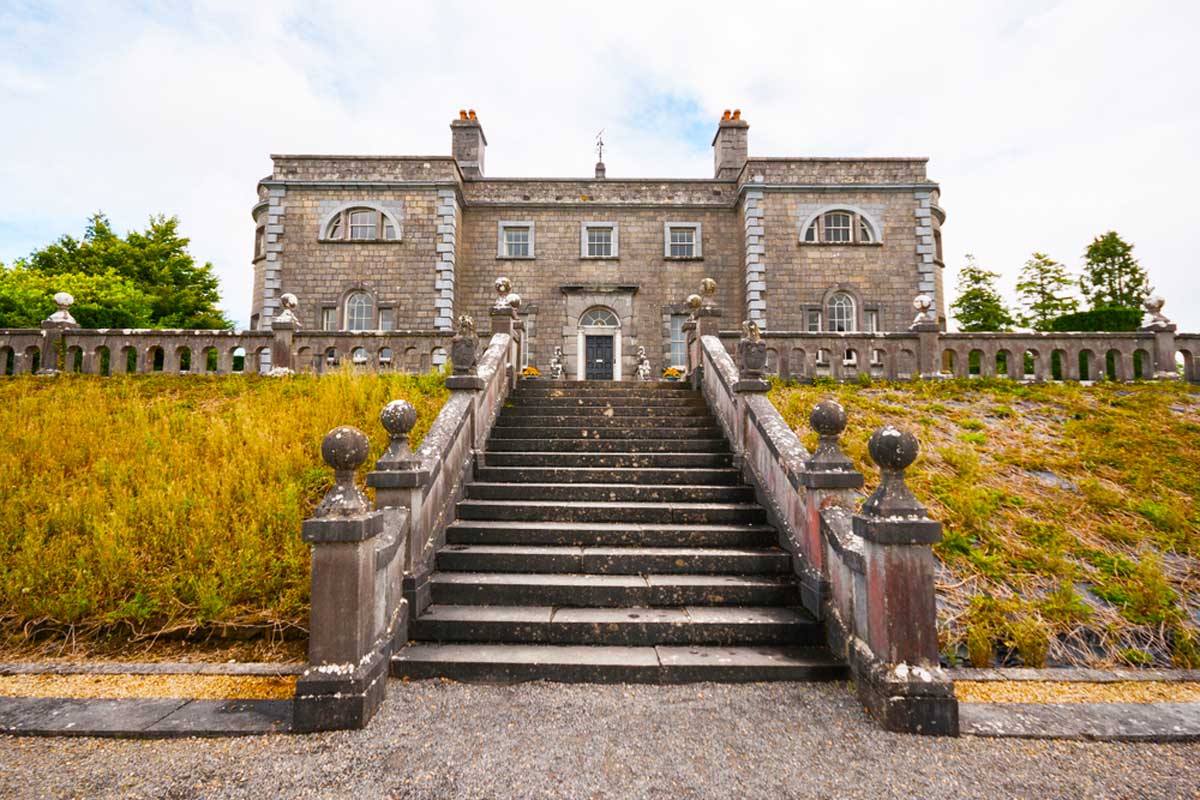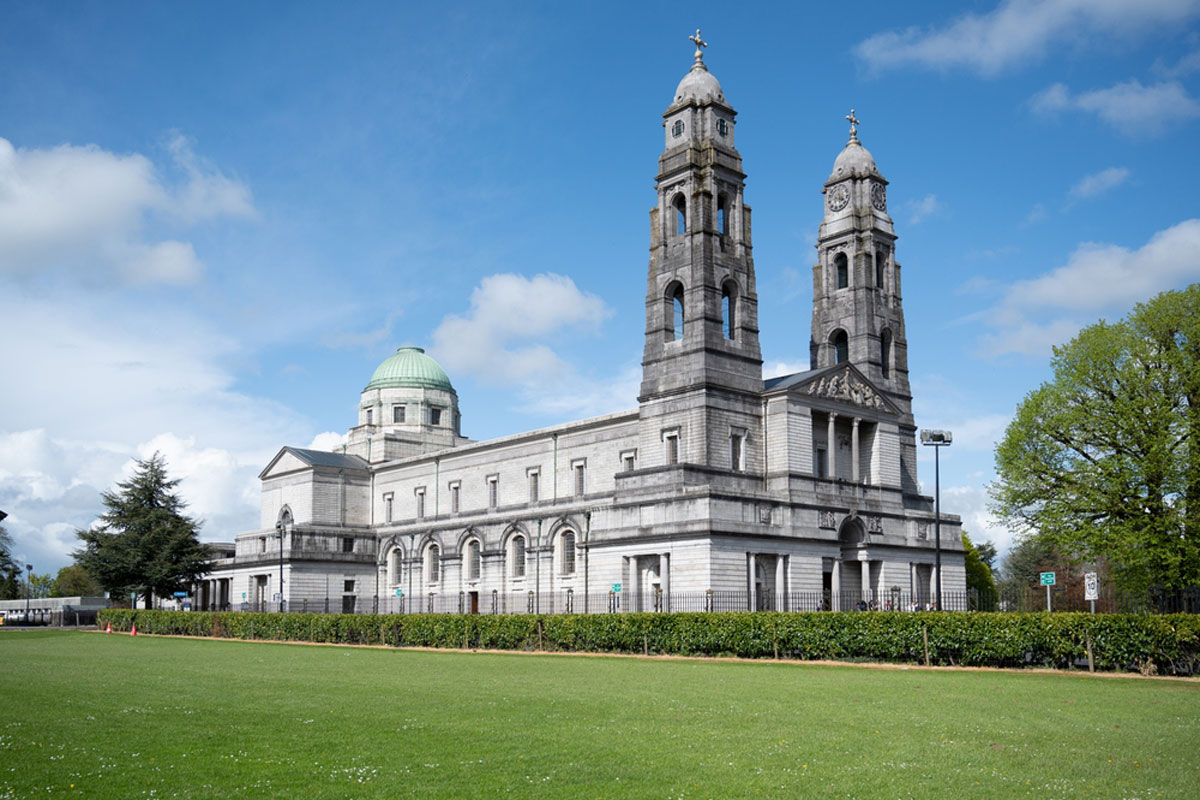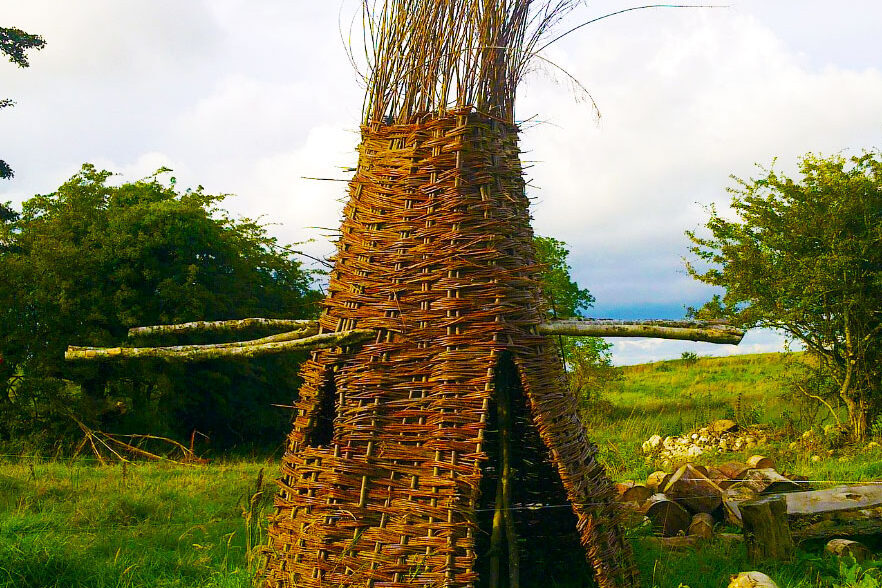A Legacy of Elegance and Intrigue
Nestled near Mullingar, County Westmeath, Belvedere House, Gardens & Park is a stunning 18th-century Georgian villa that exudes both architectural grandeur and historical mystery. With its rich past, magnificent landscapes, and unique follies, the estate is a testament to Ireland’s aristocratic heritage.
A Vision of Grandeur
Belvedere House was commissioned in 1740 by Robert Rochfort, the 1st Earl of Belvedere. Designed by renowned architect Richard Castle, the house was intended to be a hunting and summer retreat rather than a primary residence. The villa’s Palladian-inspired design, symmetrical proportions, and large sash windows offer a glimpse into the refined tastes of Ireland’s Georgian elite.
Stepping inside, visitors are transported back in time. The lavishly decorated interiors feature ornate plasterwork, grand fireplaces, and period furnishings, reflecting the wealth and sophistication of its original owner. The elegant drawing rooms and dining halls once entertained Ireland’s most influential figures, making the house a symbol of power and prestige.
A Family’s Tragic History
While Belvedere House is admired for its beauty, it is also shrouded in scandal and betrayal. Robert Rochfort’s personal life was filled with turmoil, particularly in his relationship with his wife, Mary Molesworth. Accused of infidelity, she was imprisoned by Rochfort in their home for over 30 years, a dark chapter that adds an eerie layer to the estate’s history.
This tale of isolation and cruelty left an indelible mark on the property, shaping its reputation as a place of both beauty and sorrow. Many visitors claim to feel the presence of its troubled past lingering in the house’s halls, making it an intriguing destination for history enthusiasts and mystery seekers alike.
An Introduction to the Estate
Beyond the house itself, the 160-acre estate boasts lush gardens, peaceful woodland walks, and striking architectural features. The landscape is a harmonious blend of formal and wild beauty, carefully curated to complement the elegance of the villa. Notable among these is the Jealous Wall, a dramatic Gothic ruin with a fascinating backstory, which will be explored in the next installment.
The Enchanting Gardens and Parklands
Beyond the stately elegance of Belvedere House, the surrounding 160 acres of parkland and gardens offer a breathtaking escape into nature. Carefully designed to complement the grandeur of the estate, the gardens feature a mix of formal landscaping and wild beauty, making them a haven for both history lovers and outdoor enthusiasts.
The Walled Garden: A Hidden Sanctuary
One of the highlights of the estate is the restored 18th-century Walled Garden, a secluded paradise bursting with color and fragrance. Enclosed by high stone walls, this tranquil space was originally used to grow exotic fruits, vegetables, and medicinal herbs for the Rochfort family. Today, the garden is a masterpiece of horticulture, featuring:
- Vibrant flower beds with seasonal blooms
- Climbing roses and ivy-draped walls
- Neatly manicured hedges and pathways
- Ornamental fountains and seating areas
The Walled Garden is not just a place of beauty but also a historical nod to the Georgian era’s love for cultivated landscapes, reflecting both aesthetic and practical purposes.
Woodland Walks: A Journey Through Nature
For those seeking a more immersive experience, Belvedere’s woodland trails provide the perfect opportunity to explore the estate’s natural beauty. The network of walking paths meanders through towering trees, offering stunning views of Lough Ennell and the surrounding countryside. Wildlife thrives here, with songbirds, red squirrels, and deer often spotted along the trails.
As visitors wander through these paths, they encounter ancient oaks, beech trees, and hidden follies, all of which add to the estate’s storybook atmosphere. The seasonal transformations—from vibrant spring blossoms to fiery autumn hues—make the parklands a year-round attraction.
Lakeside Views and Tranquil Escapes
Belvedere House is set on the shores of Lough Ennell, a picturesque lake that enhances the estate’s scenic charm. Visitors can enjoy:
- Peaceful lakeside strolls along the water’s edge
- Scenic picnic spots with breathtaking views
- Birdwatching opportunities, as the lake is home to many native and migratory species
The lakeside location not only adds to the serene ambiance but also highlights why Robert Rochfort chose this site for his grand retreat. The reflections of the house and gardens in the water create an almost dreamlike atmosphere, adding to the estate’s timeless beauty.
A Landscape of Stories
Every part of Belvedere’s gardens and parklands tells a story, whether through the careful planting of the Walled Garden, the hidden paths of the woodlands, or the calming presence of the lake. Yet, the most famous structure on the estate—the Jealous Wall—holds a tale of rivalry, bitterness, and architectural drama.
The Jealous Wall – A Monument to Envy
Among the many striking features of Belvedere House & Gardens, none is as dramatic or as steeped in intrigue and bitterness as the Jealous Wall. Standing at nearly 180 feet long and 30 feet high, this imposing Gothic ruin is Ireland’s largest folly—a structure built not for function, but for show. However, behind its dramatic presence lies a tale of family rivalry, jealousy, and revenge.
A Family Feud Turned to Stone
The Jealous Wall owes its existence to the long-running feud between Robert Rochfort, the 1st Earl of Belvedere, and his brother, George Rochfort. After Robert moved into Belvedere House in the mid-18th century, his brother built a grand and stately mansion, Tudenham Park House, on adjacent land.
Tudenham Park House was larger, more magnificent, and visible from Belvedere’s windows—a constant reminder to Robert of his brother’s wealth and social status. Consumed by resentment and wounded pride, Robert decided to block his view of Tudenham by constructing a massive, ruined-looking wall that would completely obscure the sight of his rival’s estate.
A Ruin Built to Deceive
Unlike genuine medieval ruins that crumble over centuries, the Jealous Wall was designed to look like an ancient, decaying fortress from the very start. It features:
- Crumbling stone towers
- Gothic-style archways
- Jagged, broken battlements
- A deliberately ruined, eerie facade
The result is an elaborate illusion—a structure meant to appear like the remains of an abandoned castle, blending seamlessly into the estate’s dramatic landscape. Its artificial decay was carefully crafted, turning the Jealous Wall into an early example of architectural deception.
A Symbol of Excess and Isolation
While the Jealous Wall stands as a testament to Robert Rochfort’s pettiness and pride, it also reflects his reclusive and vengeful nature. Known as “The Wicked Earl,” Rochfort was infamous for imprisoning his own wife, Mary Molesworth, for over 30 years after accusing her of infidelity. As a result, he lived in increasing isolation, alienated from his family and the wider aristocratic circles of Ireland.
The construction of the Jealous Wall—despite being purely decorative—became a physical representation of his bitterness, cutting him off from his brother while simultaneously advertising his wealth and ability to indulge in extravagant projects.
A Haunting Beauty
Today, the Jealous Wall remains one of the most fascinating follies in Ireland. Its towering ruins, overgrown with ivy and standing in eerie solitude, create a striking contrast against the elegant backdrop of Belvedere House and its gardens. Visitors walking beneath its archways can almost feel the weight of the rivalries and resentments that shaped its creation.
While the wall no longer serves as a barrier between feuding brothers, it stands as a powerful symbol of the lengths to which pride and jealousy can drive a man. It is a must-see feature for anyone visiting Belvedere House, offering both a glimpse into the estate’s dramatic past and a spectacular photo opportunity.

The House of Secrets and Splendor
While the gardens, parklands, and the Jealous Wall add an air of mystery and beauty to the estate, it is within Belvedere House itself that the full story of its luxury, intrigue, and isolation unfolds. This 18th-century Georgian villa, designed by Richard Castle, is an architectural masterpiece that blends elegance with a tragic past.
A Grand Georgian Retreat
Built in 1740 as a hunting and summer lodge for Robert Rochfort, the 1st Earl of Belvedere, the house was intended as a display of status and refinement rather than a permanent residence. Unlike larger mansions of the time, Belvedere House is compact yet exquisitely designed, with a focus on proportion, symmetry, and understated grandeur.
Upon entering, visitors are greeted by:
- High ceilings and large sash windows that flood the rooms with natural light
- Ornate plasterwork crafted by renowned stuccodore Barthelemij Cramillion
- Marble fireplaces and intricate wood paneling
- Period furnishings that recreate the lifestyle of 18th-century aristocrats
Each room tells a story of wealth, culture, and personal ambition, making the house a living museum of Georgian opulence.
The Specter of the Wicked Earl
Despite its beauty, Belvedere House carries an air of sadness, deeply tied to its original owner. Robert Rochfort’s reputation as “The Wicked Earl” stems not only from his rivalry with his brother (which led to the construction of the Jealous Wall) but also from his cruelty toward his own wife, Mary Molesworth.
After accusing her of infidelity, Robert imprisoned Mary in their other home for over 30 years, refusing her visitors or even access to their children. This dark chapter casts a shadow over the estate’s grandeur, making it a place where beauty and tragedy coexist. Some even say that a lingering sadness can still be felt in its halls, adding to the house’s haunting allure.
Rooms of Elegance and Legacy
Each room in Belvedere House offers a glimpse into a bygone era of aristocratic splendor:
- The Drawing Room: With its intricate plaster ceiling and large bay windows overlooking Lough Ennell, this was a space for entertaining guests and discussing matters of importance.
- The Dining Hall: A lavish setting for feasts, where candlelight and fine china set the stage for Georgian indulgence.
- The Library: Once filled with rare books and manuscripts, this room was a reflection of Rochfort’s intellectual aspirations.
- The Bedrooms: Although less ornate than the public rooms, the bedrooms offer a more personal look into the lives of those who once lived here.
Walking through these rooms, visitors can imagine the lavish gatherings, whispered conspiracies, and lonely nights that shaped the house’s history.
A House Frozen in Time
Thanks to careful restoration efforts, Belvedere House remains a remarkably well-preserved example of 18th-century Irish architecture. Unlike many grand estates that have been lost to time, Belvedere stands as a testament to its era—both in beauty and in tragedy.
A Living Legacy and Modern Revival
While Belvedere House, Gardens & Park is steeped in history, it is far from a relic of the past. Thanks to dedicated restoration efforts and cultural initiatives, this once-private estate has been transformed into one of Ireland’s most beloved heritage sites. Today, Belvedere is a place where history, nature, and modern recreation seamlessly blend, drawing visitors from near and far to experience its unique charm.
Restoration and Preservation: Bringing the Past to Life
By the late 20th century, Belvedere House had fallen into disrepair, with much of its original grandeur hidden beneath the wear of time. Recognizing its historical and architectural significance, Westmeath County Council undertook an extensive restoration project to preserve the house and its surroundings.
These efforts have:
- Restored original Georgian features, including plasterwork, wood paneling, and decorative ceilings
- Furnished rooms with authentic period pieces to recreate the atmosphere of the 18th century
- Repaired the estate’s gardens, walking trails, and iconic follies, ensuring they remain accessible to visitors
- Maintained the Jealous Wall, allowing guests to experience its haunting beauty up close
Thanks to these efforts, Belvedere House is not just a historical site, but a living museum, offering visitors an authentic glimpse into the past.
A Hub for Cultural Events and Outdoor Activities
Today, Belvedere is more than a historic estate—it has evolved into a vibrant cultural and recreational destination. Throughout the year, it hosts a variety of events and activities that cater to history buffs, nature lovers, and families alike.
Some highlights include:
- Seasonal Festivals: From springtime garden festivals to Christmas markets, Belvedere is alive with seasonal celebrations.
- Open-Air Concerts & Theatre: The parklands provide a stunning backdrop for live music performances and outdoor plays, bringing modern entertainment to an 18th-century setting.
- Guided Tours & Historical Talks: Visitors can delve deeper into the estate’s history through expert-led tours, uncovering hidden stories and architectural details.
- Art Exhibitions & Workshops: The estate often hosts local artists and craftspeople, making it a hub for creative expression.
- Family-Friendly Activities: With woodland trails, a fairy garden, and picnic areas, Belvedere is a favorite among families looking for a day out in nature.
Exploring Belvedere Today: A Visitor’s Experience
For those planning a visit, Belvedere House, Gardens & Park offers something for everyone:
- History Enthusiasts can admire the elegant Georgian architecture and explore the dark past of the Wicked Earl.
- Nature Lovers can wander through the restored Walled Garden, woodland trails, and lakeside walks.
- Photographers will find endless inspiration, from the romantic ruins of the Jealous Wall to the stunning views of Lough Ennell.
- Families can enjoy an educational yet fun experience, with interactive exhibits, playgrounds, and outdoor adventure trails.
A Timeless Destination
From its scandalous past to its modern-day revival, Belvedere House, Gardens & Park remains one of Ireland’s most captivating heritage sites. It is a place where history whispers through the walls, nature thrives in harmony with human craftsmanship, and visitors can immerse themselves in a timeless world of beauty and intrigue.
Whether you’re visiting for the history, the landscape, or the events, Belvedere is a must-see destination that continues to enchant all who step through its gates.
County Westmeath, located in the heart of Ireland, is renowned for its stunning lakes, rich history, and vibrant towns. Here’s a guide to its most notable tourist attractions:
Historical and Cultural Sites
- Belvedere House and Gardens: A magnificent 18th-century estate featuring gardens, woodland walks, and the famous Jealous Wall.
- Mullingar Cathedral of Christ the King: A beautiful neo-Romanesque cathedral with striking mosaics.
- Fore Abbey: A historic monastic site with fascinating legends, such as the “Seven Wonders of Fore.”
- Tullynally Castle and Gardens: A Gothic revival castle with extensive gardens, lakes, and woodland trails.
- Kilbeggan Distillery: Ireland’s oldest licensed distillery, offering guided tours and whiskey tastings.
Natural Attractions
- Lough Ennell: A serene lake ideal for fishing, boating, and birdwatching.
- Lough Owel: A popular spot for angling and water sports, surrounded by picturesque landscapes.
- Lough Derravaragh: Famous for its connection to the legend of the Children of Lir, offering fishing and kayaking opportunities.
- Mullaghmeen Forest: The largest planted beech forest in Ireland, perfect for hiking and picnics.
- Royal Canal Greenway: A scenic walking and cycling route following the historic canal.
Scenic Drives and Villages
- Mullingar: The county town known for its vibrant arts scene, shops, and lively pubs.
- Athlone: A bustling town on the River Shannon, featuring historical landmarks and riverside charm.
- Glasson: A picturesque village often referred to as the “Village of the Roses,” with excellent restaurants and access to Lough Ree.
- Castlepollard: A charming town near Fore Abbey and several tranquil lakes.
- Moate: A historic market town with heritage sites and scenic surroundings.
Lakes and Water Activities
- Lough Ree: One of Ireland’s largest lakes, perfect for boating, fishing, and exploring its islands.
- River Shannon: Offers cruising, kayaking, and riverside trails.
- Lough Ennell: A favorite for anglers and nature lovers.
- Lough Owel: Known for its crystal-clear waters and scenic beauty.
- Lough Derravaragh: A peaceful spot steeped in myth and ideal for water sports.
Unique Experiences
- Athlone Castle Visitor Centre: A restored castle with interactive exhibitions on local history.
- Dún na Sí Amenity and Heritage Park: A cultural park showcasing traditional Irish music, crafts, and heritage.
- Mount Temple Golf Club: A scenic golf course surrounded by lush countryside.
- Lilliput Adventure Centre: An activity hub on the shores of Lough Ennell, offering kayaking, climbing, and team-building activities.
- Hill of Uisneach: A significant ancient site considered the mythological and geographical center of Ireland.
County Westmeath is a treasure trove of lakeside beauty, historical wonders, and cultural experiences. Whether you’re exploring the legends of Fore Abbey or enjoying the tranquility of Lough Ree, this county offers a memorable journey through Ireland’s heartland.
Helpful Resources






